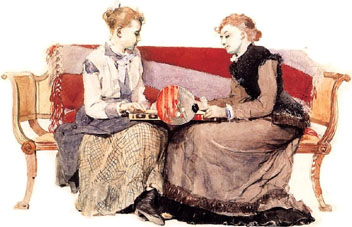|
| Magriel's NYT Columns |
 This last summer a major backgammon tournament for the benefit of the Children’s Cancer Fund of America was held in Westhampton, L.I. Tanner Hirsch directed the event. Lila Swan was tournament coordinator.
This last summer a major backgammon tournament for the benefit of the Children’s Cancer Fund of America was held in Westhampton, L.I. Tanner Hirsch directed the event. Lila Swan was tournament coordinator.
Steve Zolotow took first place by beating Joel Silverman in the finals, after having overcome Bruce Leib in the semifinals. In the consolation flight, Jeff Westheimer defeated Sue Bender. Jim Chew bested Blackwell Williams to take the last-chance competition. Francesca Booke was victorious among the intermediates. The women’s prize was shared by Lee Genud and Joan Ault.
The 25-point finals match between Zolotow and Silverman was particularly exciting, with the lead seesawing back and forth from the opening. Zolotow finally pulled out with a commanding 18-10 advantage. Silverman, who had managed to beat two of the world’s top-ranked players, Oswald Jacoby and Gino Scalamandre, to qualify for the finals, wasn’t giving up.
He fought back to tie the score 20–20, but fell behind again, 23–20. In the following game, Silverman doubled early and appeared to have no chance until a miraculous series of rolls turned the game around and he scored a gammon to take the lead, 24–23. Zolotow won the next game and the score was tied at double match point, 24–24.
The diagrammed position is taken from the last and deciding game, on which the entire match depended. Zolotow (Black) had a seemingly hopeless position until he rolled an astonishing 1-6 from the bar to reenter and hit Silverman (White) on the 18-point. One roll later, the position illustrated was reached, with Black now the overwhelming favorite.
|
24
MATCH TO 25 24 |
| Black to play 5-5. |
He decided to “switch” points, using two of his 5’s to move 6/1*(2). With this play, Black relinquishes the 6-point and makes the 1-point while hitting a second opposing blot. By switching points, Black ends the possibility of White’s reentering and establishing Black’s 1-point. Even the most careful play against a well-timed 1-point game often results in leaving shots.
The complete correct play for Black is 6/1*(2), 18/8. With the remaining two 5’s, Black still had to exercise caution, even though White now had two men on the bar.
Notice that if Black had carelessly played either 15/5 or 18/13, 15/10, he would be exposed to White both reentering and hitting with 6-6 on the next roll. By playing 18/8, Black denied White even this small possibility for a comeback.
The possibility of switching points in one’s home board is often overlooked, but one that players should be alert to whenever they roll doubles. In the opening and middle games, relinquishing the 6-point is rarely advisable. However, as a prelude to bearing off, switching is often a sound strategy.
Rollout
 Tom Keith 2013 |
|
Match to 25 White 24, Black 24 Black rolls 5-5 1296 games with VR Checker play: 2-ply Cube play: 3-ply Red |
| 5-5: | Game | G | BG | Equity | ||||
| 1 | 18/8, 6/1*(2) |
W L |
.9251 .0749 |
.8064 .0030 |
.0020 .0001 | +0.8503 |

| |
| 2 | 15/5, 6/1*(2) |
W L |
.9063 .0937 |
.7985 .0024 |
.0022 .0000 | +0.8126 | (0.0377) | |
| 3 | 18/13, 15/10, 6/1*(2) |
W L |
.9061 .0939 |
.8049 .0066 |
.0020 .0001 | +0.8123 | (0.0380) | |
| 4 | 18/8, 15/5 |
W L |
.8327 .1673 |
.6494 .0028 |
.0975 .0001 | +0.6654 | (0.1849) |

|
|

